General Systems Management, Risk, and Business Value Analysis
VerifiedAdded on 2021/06/17
|9
|2726
|24
Report
AI Summary
This report comprehensively examines general systems management, organizational structures, and their impact on business operations. It delves into the importance of engineering risk management, including risk identification, analysis, and mitigation strategies. The report also explores portfolio alignment, emphasizing its role in resource allocation and prioritization, alongside a discussion on business value and its measurement. Furthermore, it provides an overview of the portfolio management process cycle, highlighting key steps from strategy establishment to project management. The analysis extends to organizational maturity and its significance for decision-making. Finally, the report includes a case study of the Deepwater Horizon oil spill, analyzing its causes and implications related to management, communication, and risk assessment failures. The report concludes with a summary of key concepts and their practical applications in organizational settings.
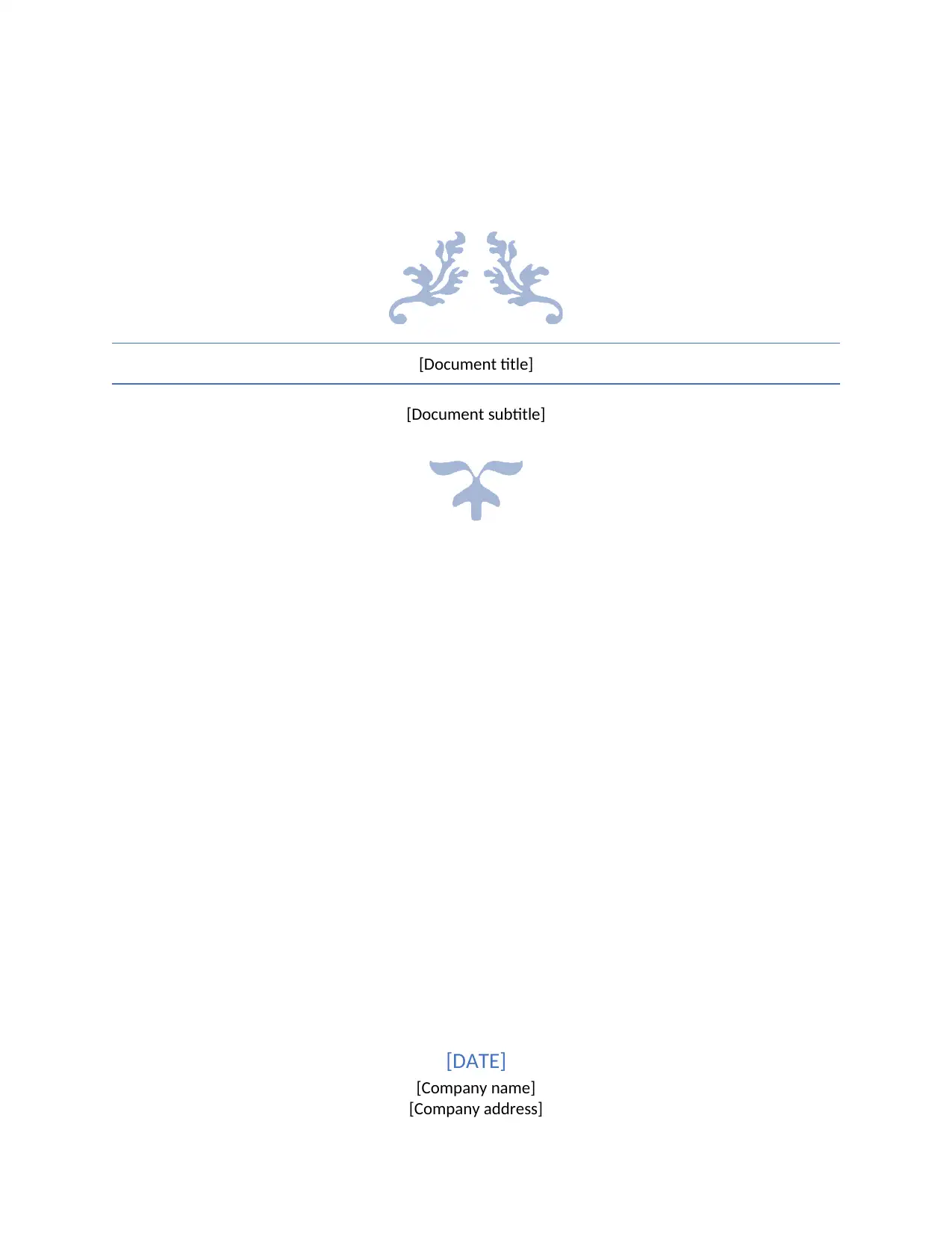
[Document title]
[Document subtitle]
[DATE]
[Company name]
[Company address]
[Document subtitle]
[DATE]
[Company name]
[Company address]
Paraphrase This Document
Need a fresh take? Get an instant paraphrase of this document with our AI Paraphraser
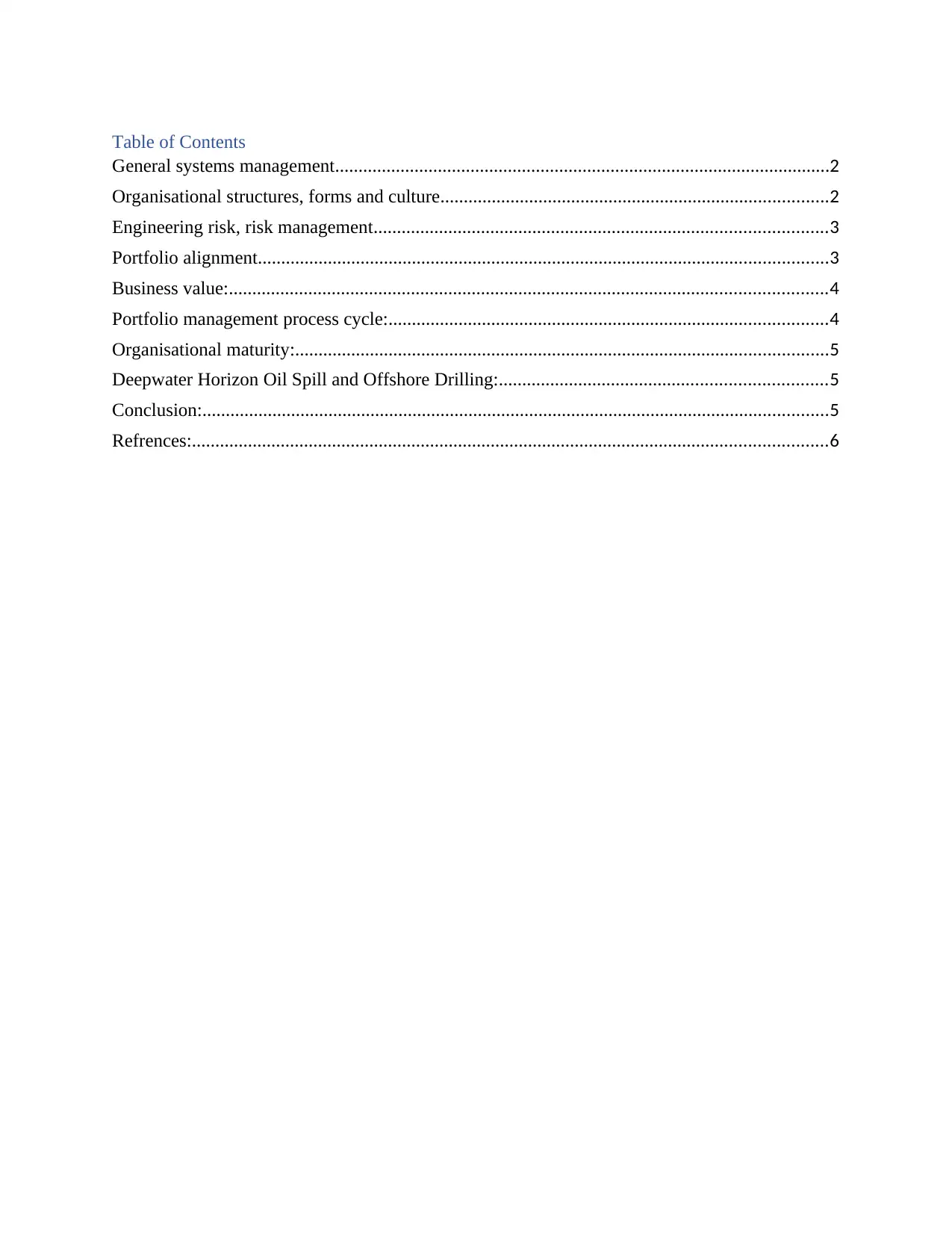
Table of Contents
General systems management..........................................................................................................2
Organisational structures, forms and culture...................................................................................2
Engineering risk, risk management.................................................................................................3
Portfolio alignment..........................................................................................................................3
Business value:................................................................................................................................4
Portfolio management process cycle:..............................................................................................4
Organisational maturity:..................................................................................................................5
Deepwater Horizon Oil Spill and Offshore Drilling:......................................................................5
Conclusion:......................................................................................................................................5
Refrences:........................................................................................................................................6
General systems management..........................................................................................................2
Organisational structures, forms and culture...................................................................................2
Engineering risk, risk management.................................................................................................3
Portfolio alignment..........................................................................................................................3
Business value:................................................................................................................................4
Portfolio management process cycle:..............................................................................................4
Organisational maturity:..................................................................................................................5
Deepwater Horizon Oil Spill and Offshore Drilling:......................................................................5
Conclusion:......................................................................................................................................5
Refrences:........................................................................................................................................6
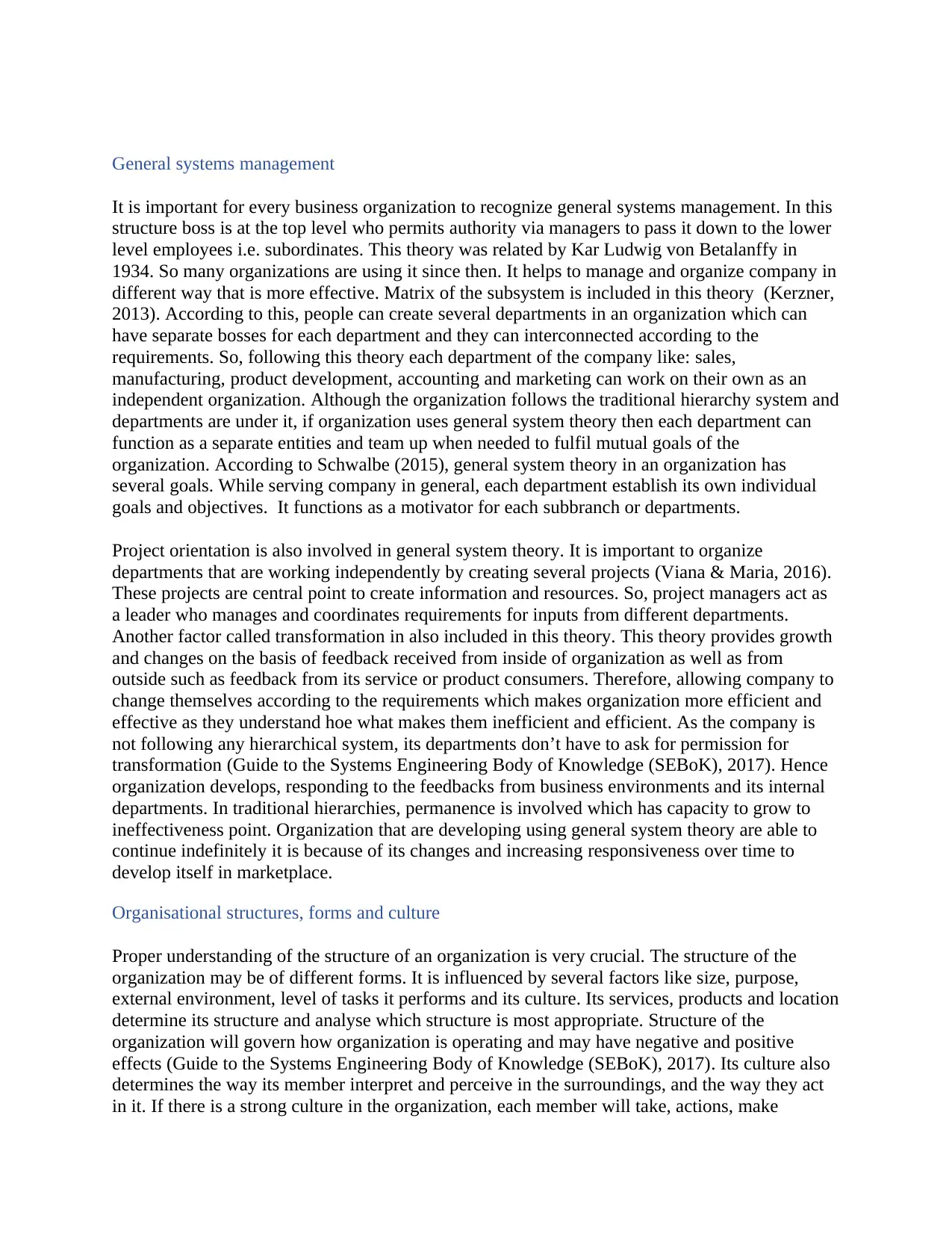
General systems management
It is important for every business organization to recognize general systems management. In this
structure boss is at the top level who permits authority via managers to pass it down to the lower
level employees i.e. subordinates. This theory was related by Kar Ludwig von Betalanffy in
1934. So many organizations are using it since then. It helps to manage and organize company in
different way that is more effective. Matrix of the subsystem is included in this theory (Kerzner,
2013). According to this, people can create several departments in an organization which can
have separate bosses for each department and they can interconnected according to the
requirements. So, following this theory each department of the company like: sales,
manufacturing, product development, accounting and marketing can work on their own as an
independent organization. Although the organization follows the traditional hierarchy system and
departments are under it, if organization uses general system theory then each department can
function as a separate entities and team up when needed to fulfil mutual goals of the
organization. According to Schwalbe (2015), general system theory in an organization has
several goals. While serving company in general, each department establish its own individual
goals and objectives. It functions as a motivator for each subbranch or departments.
Project orientation is also involved in general system theory. It is important to organize
departments that are working independently by creating several projects (Viana & Maria, 2016).
These projects are central point to create information and resources. So, project managers act as
a leader who manages and coordinates requirements for inputs from different departments.
Another factor called transformation in also included in this theory. This theory provides growth
and changes on the basis of feedback received from inside of organization as well as from
outside such as feedback from its service or product consumers. Therefore, allowing company to
change themselves according to the requirements which makes organization more efficient and
effective as they understand hoe what makes them inefficient and efficient. As the company is
not following any hierarchical system, its departments don’t have to ask for permission for
transformation (Guide to the Systems Engineering Body of Knowledge (SEBoK), 2017). Hence
organization develops, responding to the feedbacks from business environments and its internal
departments. In traditional hierarchies, permanence is involved which has capacity to grow to
ineffectiveness point. Organization that are developing using general system theory are able to
continue indefinitely it is because of its changes and increasing responsiveness over time to
develop itself in marketplace.
Organisational structures, forms and culture
Proper understanding of the structure of an organization is very crucial. The structure of the
organization may be of different forms. It is influenced by several factors like size, purpose,
external environment, level of tasks it performs and its culture. Its services, products and location
determine its structure and analyse which structure is most appropriate. Structure of the
organization will govern how organization is operating and may have negative and positive
effects (Guide to the Systems Engineering Body of Knowledge (SEBoK), 2017). Its culture also
determines the way its member interpret and perceive in the surroundings, and the way they act
in it. If there is a strong culture in the organization, each member will take, actions, make
It is important for every business organization to recognize general systems management. In this
structure boss is at the top level who permits authority via managers to pass it down to the lower
level employees i.e. subordinates. This theory was related by Kar Ludwig von Betalanffy in
1934. So many organizations are using it since then. It helps to manage and organize company in
different way that is more effective. Matrix of the subsystem is included in this theory (Kerzner,
2013). According to this, people can create several departments in an organization which can
have separate bosses for each department and they can interconnected according to the
requirements. So, following this theory each department of the company like: sales,
manufacturing, product development, accounting and marketing can work on their own as an
independent organization. Although the organization follows the traditional hierarchy system and
departments are under it, if organization uses general system theory then each department can
function as a separate entities and team up when needed to fulfil mutual goals of the
organization. According to Schwalbe (2015), general system theory in an organization has
several goals. While serving company in general, each department establish its own individual
goals and objectives. It functions as a motivator for each subbranch or departments.
Project orientation is also involved in general system theory. It is important to organize
departments that are working independently by creating several projects (Viana & Maria, 2016).
These projects are central point to create information and resources. So, project managers act as
a leader who manages and coordinates requirements for inputs from different departments.
Another factor called transformation in also included in this theory. This theory provides growth
and changes on the basis of feedback received from inside of organization as well as from
outside such as feedback from its service or product consumers. Therefore, allowing company to
change themselves according to the requirements which makes organization more efficient and
effective as they understand hoe what makes them inefficient and efficient. As the company is
not following any hierarchical system, its departments don’t have to ask for permission for
transformation (Guide to the Systems Engineering Body of Knowledge (SEBoK), 2017). Hence
organization develops, responding to the feedbacks from business environments and its internal
departments. In traditional hierarchies, permanence is involved which has capacity to grow to
ineffectiveness point. Organization that are developing using general system theory are able to
continue indefinitely it is because of its changes and increasing responsiveness over time to
develop itself in marketplace.
Organisational structures, forms and culture
Proper understanding of the structure of an organization is very crucial. The structure of the
organization may be of different forms. It is influenced by several factors like size, purpose,
external environment, level of tasks it performs and its culture. Its services, products and location
determine its structure and analyse which structure is most appropriate. Structure of the
organization will govern how organization is operating and may have negative and positive
effects (Guide to the Systems Engineering Body of Knowledge (SEBoK), 2017). Its culture also
determines the way its member interpret and perceive in the surroundings, and the way they act
in it. If there is a strong culture in the organization, each member will take, actions, make
⊘ This is a preview!⊘
Do you want full access?
Subscribe today to unlock all pages.

Trusted by 1+ million students worldwide
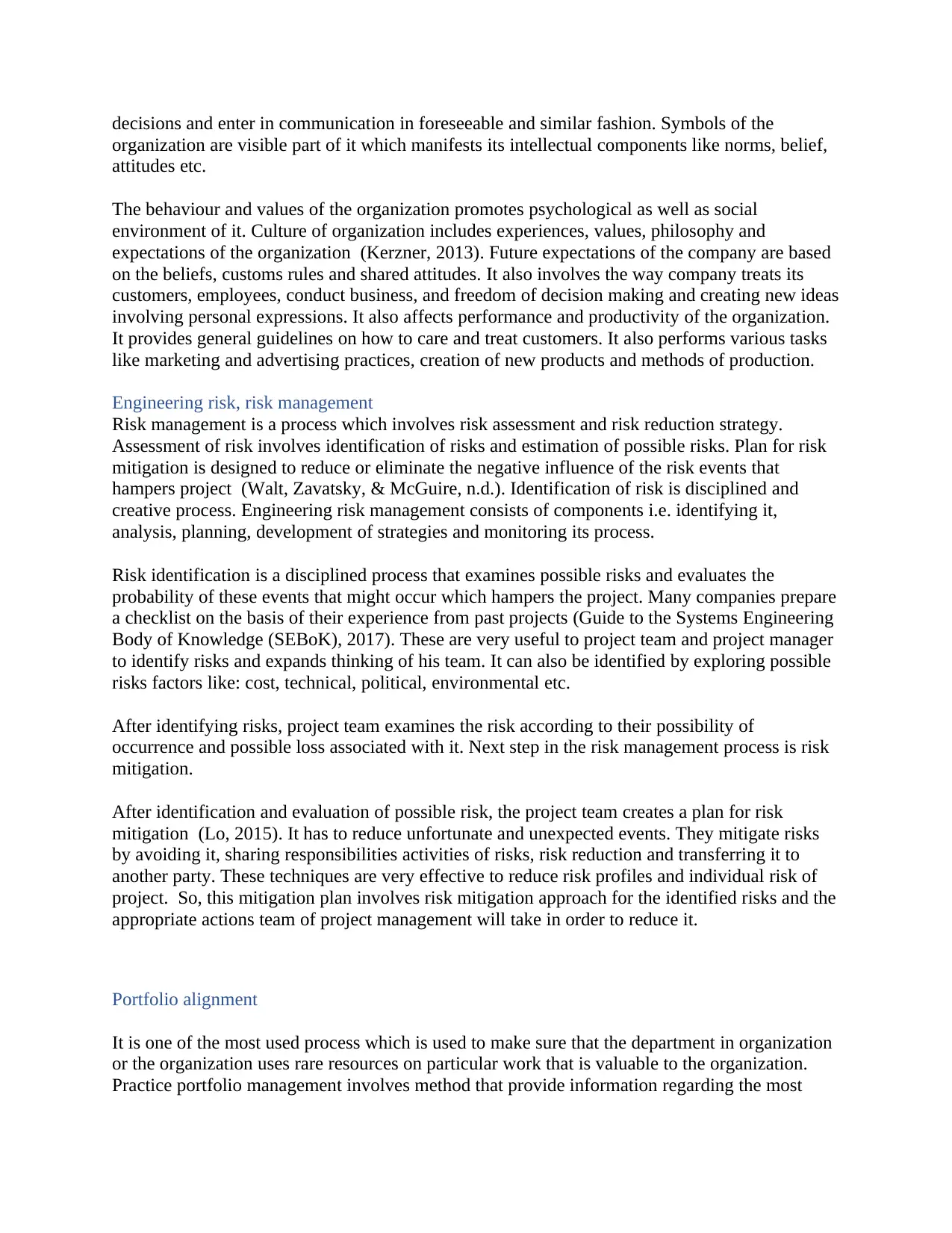
decisions and enter in communication in foreseeable and similar fashion. Symbols of the
organization are visible part of it which manifests its intellectual components like norms, belief,
attitudes etc.
The behaviour and values of the organization promotes psychological as well as social
environment of it. Culture of organization includes experiences, values, philosophy and
expectations of the organization (Kerzner, 2013). Future expectations of the company are based
on the beliefs, customs rules and shared attitudes. It also involves the way company treats its
customers, employees, conduct business, and freedom of decision making and creating new ideas
involving personal expressions. It also affects performance and productivity of the organization.
It provides general guidelines on how to care and treat customers. It also performs various tasks
like marketing and advertising practices, creation of new products and methods of production.
Engineering risk, risk management
Risk management is a process which involves risk assessment and risk reduction strategy.
Assessment of risk involves identification of risks and estimation of possible risks. Plan for risk
mitigation is designed to reduce or eliminate the negative influence of the risk events that
hampers project (Walt, Zavatsky, & McGuire, n.d.). Identification of risk is disciplined and
creative process. Engineering risk management consists of components i.e. identifying it,
analysis, planning, development of strategies and monitoring its process.
Risk identification is a disciplined process that examines possible risks and evaluates the
probability of these events that might occur which hampers the project. Many companies prepare
a checklist on the basis of their experience from past projects (Guide to the Systems Engineering
Body of Knowledge (SEBoK), 2017). These are very useful to project team and project manager
to identify risks and expands thinking of his team. It can also be identified by exploring possible
risks factors like: cost, technical, political, environmental etc.
After identifying risks, project team examines the risk according to their possibility of
occurrence and possible loss associated with it. Next step in the risk management process is risk
mitigation.
After identification and evaluation of possible risk, the project team creates a plan for risk
mitigation (Lo, 2015). It has to reduce unfortunate and unexpected events. They mitigate risks
by avoiding it, sharing responsibilities activities of risks, risk reduction and transferring it to
another party. These techniques are very effective to reduce risk profiles and individual risk of
project. So, this mitigation plan involves risk mitigation approach for the identified risks and the
appropriate actions team of project management will take in order to reduce it.
Portfolio alignment
It is one of the most used process which is used to make sure that the department in organization
or the organization uses rare resources on particular work that is valuable to the organization.
Practice portfolio management involves method that provide information regarding the most
organization are visible part of it which manifests its intellectual components like norms, belief,
attitudes etc.
The behaviour and values of the organization promotes psychological as well as social
environment of it. Culture of organization includes experiences, values, philosophy and
expectations of the organization (Kerzner, 2013). Future expectations of the company are based
on the beliefs, customs rules and shared attitudes. It also involves the way company treats its
customers, employees, conduct business, and freedom of decision making and creating new ideas
involving personal expressions. It also affects performance and productivity of the organization.
It provides general guidelines on how to care and treat customers. It also performs various tasks
like marketing and advertising practices, creation of new products and methods of production.
Engineering risk, risk management
Risk management is a process which involves risk assessment and risk reduction strategy.
Assessment of risk involves identification of risks and estimation of possible risks. Plan for risk
mitigation is designed to reduce or eliminate the negative influence of the risk events that
hampers project (Walt, Zavatsky, & McGuire, n.d.). Identification of risk is disciplined and
creative process. Engineering risk management consists of components i.e. identifying it,
analysis, planning, development of strategies and monitoring its process.
Risk identification is a disciplined process that examines possible risks and evaluates the
probability of these events that might occur which hampers the project. Many companies prepare
a checklist on the basis of their experience from past projects (Guide to the Systems Engineering
Body of Knowledge (SEBoK), 2017). These are very useful to project team and project manager
to identify risks and expands thinking of his team. It can also be identified by exploring possible
risks factors like: cost, technical, political, environmental etc.
After identifying risks, project team examines the risk according to their possibility of
occurrence and possible loss associated with it. Next step in the risk management process is risk
mitigation.
After identification and evaluation of possible risk, the project team creates a plan for risk
mitigation (Lo, 2015). It has to reduce unfortunate and unexpected events. They mitigate risks
by avoiding it, sharing responsibilities activities of risks, risk reduction and transferring it to
another party. These techniques are very effective to reduce risk profiles and individual risk of
project. So, this mitigation plan involves risk mitigation approach for the identified risks and the
appropriate actions team of project management will take in order to reduce it.
Portfolio alignment
It is one of the most used process which is used to make sure that the department in organization
or the organization uses rare resources on particular work that is valuable to the organization.
Practice portfolio management involves method that provide information regarding the most
Paraphrase This Document
Need a fresh take? Get an instant paraphrase of this document with our AI Paraphraser
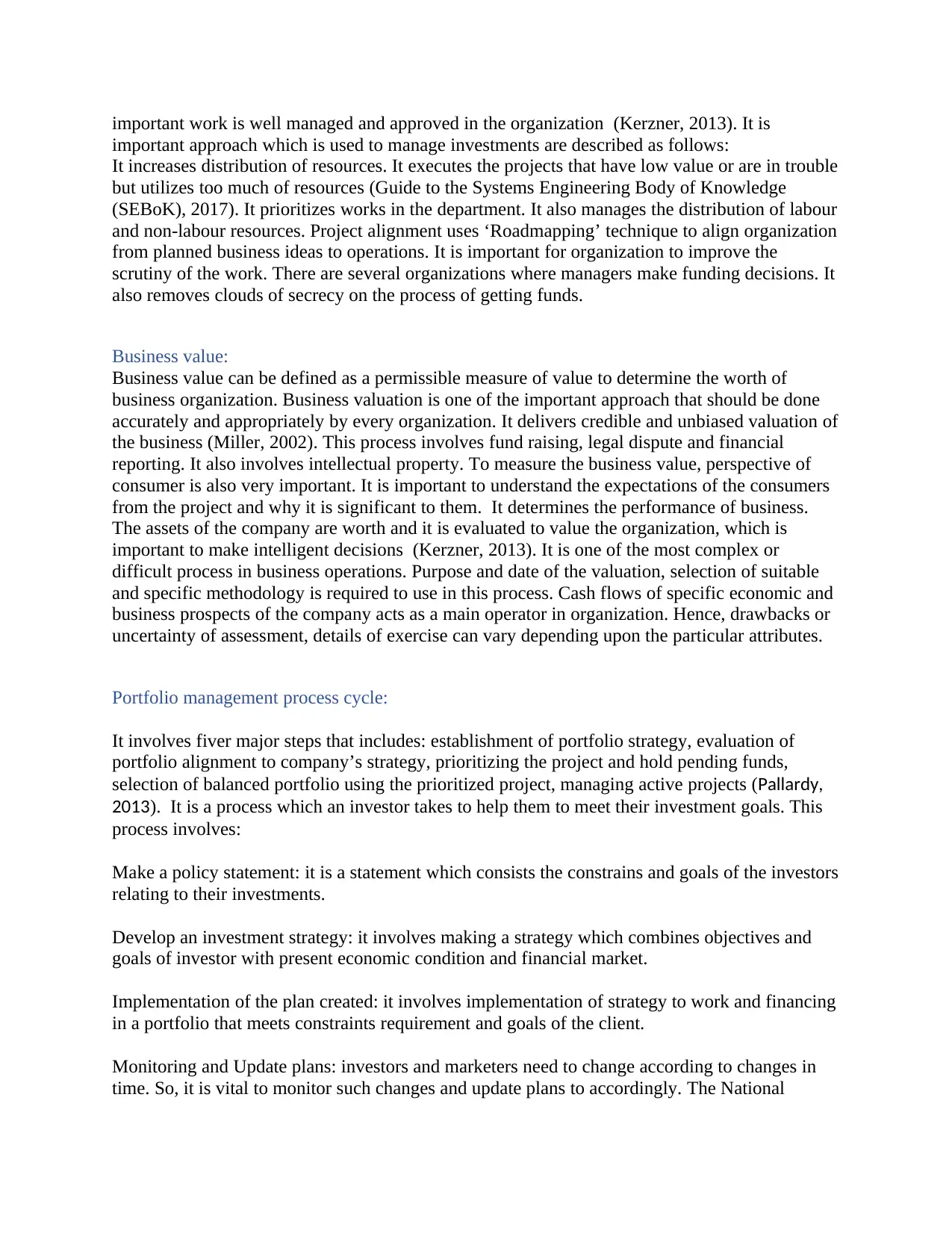
important work is well managed and approved in the organization (Kerzner, 2013). It is
important approach which is used to manage investments are described as follows:
It increases distribution of resources. It executes the projects that have low value or are in trouble
but utilizes too much of resources (Guide to the Systems Engineering Body of Knowledge
(SEBoK), 2017). It prioritizes works in the department. It also manages the distribution of labour
and non-labour resources. Project alignment uses ‘Roadmapping’ technique to align organization
from planned business ideas to operations. It is important for organization to improve the
scrutiny of the work. There are several organizations where managers make funding decisions. It
also removes clouds of secrecy on the process of getting funds.
Business value:
Business value can be defined as a permissible measure of value to determine the worth of
business organization. Business valuation is one of the important approach that should be done
accurately and appropriately by every organization. It delivers credible and unbiased valuation of
the business (Miller, 2002). This process involves fund raising, legal dispute and financial
reporting. It also involves intellectual property. To measure the business value, perspective of
consumer is also very important. It is important to understand the expectations of the consumers
from the project and why it is significant to them. It determines the performance of business.
The assets of the company are worth and it is evaluated to value the organization, which is
important to make intelligent decisions (Kerzner, 2013). It is one of the most complex or
difficult process in business operations. Purpose and date of the valuation, selection of suitable
and specific methodology is required to use in this process. Cash flows of specific economic and
business prospects of the company acts as a main operator in organization. Hence, drawbacks or
uncertainty of assessment, details of exercise can vary depending upon the particular attributes.
Portfolio management process cycle:
It involves fiver major steps that includes: establishment of portfolio strategy, evaluation of
portfolio alignment to company’s strategy, prioritizing the project and hold pending funds,
selection of balanced portfolio using the prioritized project, managing active projects (Pallardy,
2013). It is a process which an investor takes to help them to meet their investment goals. This
process involves:
Make a policy statement: it is a statement which consists the constrains and goals of the investors
relating to their investments.
Develop an investment strategy: it involves making a strategy which combines objectives and
goals of investor with present economic condition and financial market.
Implementation of the plan created: it involves implementation of strategy to work and financing
in a portfolio that meets constraints requirement and goals of the client.
Monitoring and Update plans: investors and marketers need to change according to changes in
time. So, it is vital to monitor such changes and update plans to accordingly. The National
important approach which is used to manage investments are described as follows:
It increases distribution of resources. It executes the projects that have low value or are in trouble
but utilizes too much of resources (Guide to the Systems Engineering Body of Knowledge
(SEBoK), 2017). It prioritizes works in the department. It also manages the distribution of labour
and non-labour resources. Project alignment uses ‘Roadmapping’ technique to align organization
from planned business ideas to operations. It is important for organization to improve the
scrutiny of the work. There are several organizations where managers make funding decisions. It
also removes clouds of secrecy on the process of getting funds.
Business value:
Business value can be defined as a permissible measure of value to determine the worth of
business organization. Business valuation is one of the important approach that should be done
accurately and appropriately by every organization. It delivers credible and unbiased valuation of
the business (Miller, 2002). This process involves fund raising, legal dispute and financial
reporting. It also involves intellectual property. To measure the business value, perspective of
consumer is also very important. It is important to understand the expectations of the consumers
from the project and why it is significant to them. It determines the performance of business.
The assets of the company are worth and it is evaluated to value the organization, which is
important to make intelligent decisions (Kerzner, 2013). It is one of the most complex or
difficult process in business operations. Purpose and date of the valuation, selection of suitable
and specific methodology is required to use in this process. Cash flows of specific economic and
business prospects of the company acts as a main operator in organization. Hence, drawbacks or
uncertainty of assessment, details of exercise can vary depending upon the particular attributes.
Portfolio management process cycle:
It involves fiver major steps that includes: establishment of portfolio strategy, evaluation of
portfolio alignment to company’s strategy, prioritizing the project and hold pending funds,
selection of balanced portfolio using the prioritized project, managing active projects (Pallardy,
2013). It is a process which an investor takes to help them to meet their investment goals. This
process involves:
Make a policy statement: it is a statement which consists the constrains and goals of the investors
relating to their investments.
Develop an investment strategy: it involves making a strategy which combines objectives and
goals of investor with present economic condition and financial market.
Implementation of the plan created: it involves implementation of strategy to work and financing
in a portfolio that meets constraints requirement and goals of the client.
Monitoring and Update plans: investors and marketers need to change according to changes in
time. So, it is vital to monitor such changes and update plans to accordingly. The National
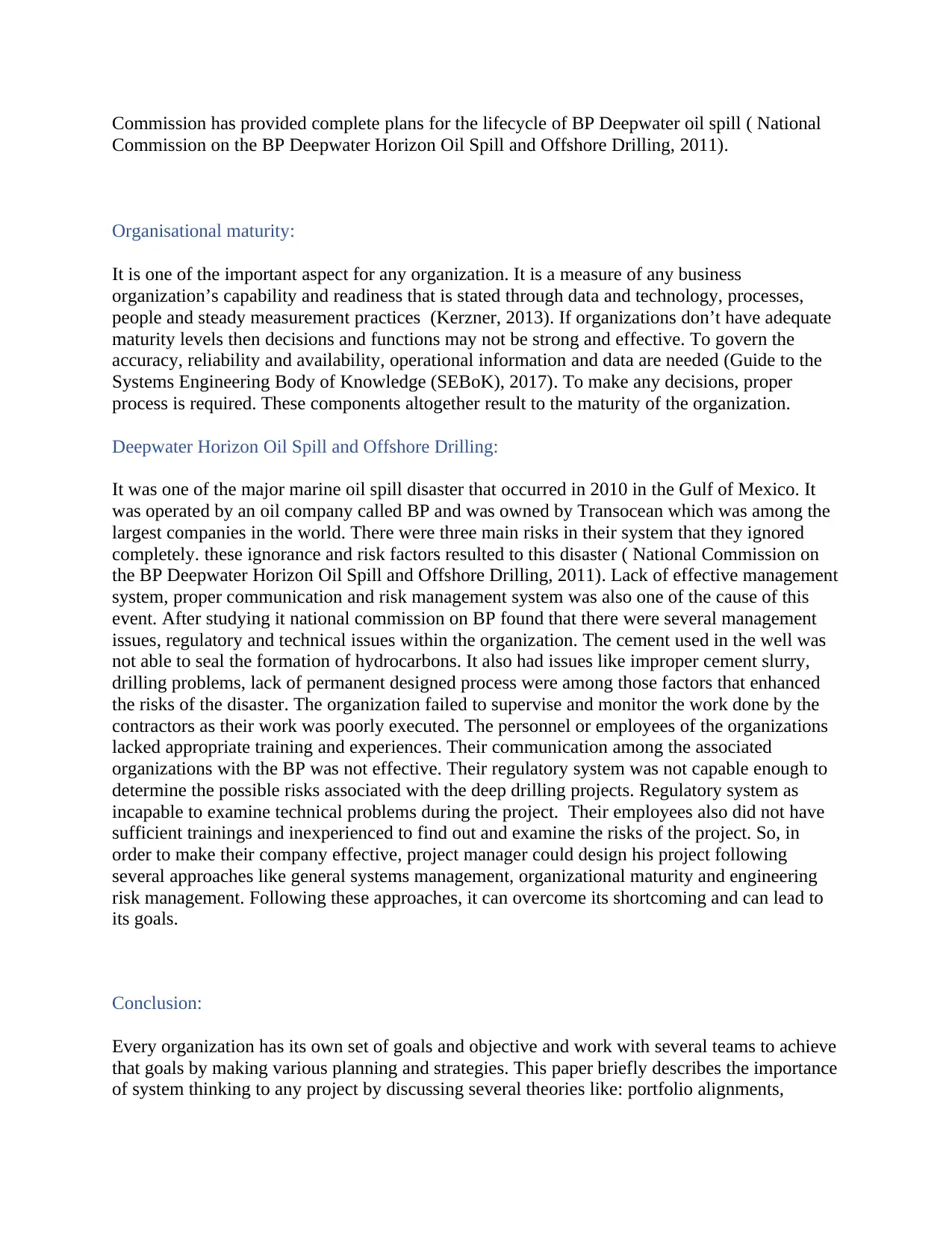
Commission has provided complete plans for the lifecycle of BP Deepwater oil spill ( National
Commission on the BP Deepwater Horizon Oil Spill and Offshore Drilling, 2011).
Organisational maturity:
It is one of the important aspect for any organization. It is a measure of any business
organization’s capability and readiness that is stated through data and technology, processes,
people and steady measurement practices (Kerzner, 2013). If organizations don’t have adequate
maturity levels then decisions and functions may not be strong and effective. To govern the
accuracy, reliability and availability, operational information and data are needed (Guide to the
Systems Engineering Body of Knowledge (SEBoK), 2017). To make any decisions, proper
process is required. These components altogether result to the maturity of the organization.
Deepwater Horizon Oil Spill and Offshore Drilling:
It was one of the major marine oil spill disaster that occurred in 2010 in the Gulf of Mexico. It
was operated by an oil company called BP and was owned by Transocean which was among the
largest companies in the world. There were three main risks in their system that they ignored
completely. these ignorance and risk factors resulted to this disaster ( National Commission on
the BP Deepwater Horizon Oil Spill and Offshore Drilling, 2011). Lack of effective management
system, proper communication and risk management system was also one of the cause of this
event. After studying it national commission on BP found that there were several management
issues, regulatory and technical issues within the organization. The cement used in the well was
not able to seal the formation of hydrocarbons. It also had issues like improper cement slurry,
drilling problems, lack of permanent designed process were among those factors that enhanced
the risks of the disaster. The organization failed to supervise and monitor the work done by the
contractors as their work was poorly executed. The personnel or employees of the organizations
lacked appropriate training and experiences. Their communication among the associated
organizations with the BP was not effective. Their regulatory system was not capable enough to
determine the possible risks associated with the deep drilling projects. Regulatory system as
incapable to examine technical problems during the project. Their employees also did not have
sufficient trainings and inexperienced to find out and examine the risks of the project. So, in
order to make their company effective, project manager could design his project following
several approaches like general systems management, organizational maturity and engineering
risk management. Following these approaches, it can overcome its shortcoming and can lead to
its goals.
Conclusion:
Every organization has its own set of goals and objective and work with several teams to achieve
that goals by making various planning and strategies. This paper briefly describes the importance
of system thinking to any project by discussing several theories like: portfolio alignments,
Commission on the BP Deepwater Horizon Oil Spill and Offshore Drilling, 2011).
Organisational maturity:
It is one of the important aspect for any organization. It is a measure of any business
organization’s capability and readiness that is stated through data and technology, processes,
people and steady measurement practices (Kerzner, 2013). If organizations don’t have adequate
maturity levels then decisions and functions may not be strong and effective. To govern the
accuracy, reliability and availability, operational information and data are needed (Guide to the
Systems Engineering Body of Knowledge (SEBoK), 2017). To make any decisions, proper
process is required. These components altogether result to the maturity of the organization.
Deepwater Horizon Oil Spill and Offshore Drilling:
It was one of the major marine oil spill disaster that occurred in 2010 in the Gulf of Mexico. It
was operated by an oil company called BP and was owned by Transocean which was among the
largest companies in the world. There were three main risks in their system that they ignored
completely. these ignorance and risk factors resulted to this disaster ( National Commission on
the BP Deepwater Horizon Oil Spill and Offshore Drilling, 2011). Lack of effective management
system, proper communication and risk management system was also one of the cause of this
event. After studying it national commission on BP found that there were several management
issues, regulatory and technical issues within the organization. The cement used in the well was
not able to seal the formation of hydrocarbons. It also had issues like improper cement slurry,
drilling problems, lack of permanent designed process were among those factors that enhanced
the risks of the disaster. The organization failed to supervise and monitor the work done by the
contractors as their work was poorly executed. The personnel or employees of the organizations
lacked appropriate training and experiences. Their communication among the associated
organizations with the BP was not effective. Their regulatory system was not capable enough to
determine the possible risks associated with the deep drilling projects. Regulatory system as
incapable to examine technical problems during the project. Their employees also did not have
sufficient trainings and inexperienced to find out and examine the risks of the project. So, in
order to make their company effective, project manager could design his project following
several approaches like general systems management, organizational maturity and engineering
risk management. Following these approaches, it can overcome its shortcoming and can lead to
its goals.
Conclusion:
Every organization has its own set of goals and objective and work with several teams to achieve
that goals by making various planning and strategies. This paper briefly describes the importance
of system thinking to any project by discussing several theories like: portfolio alignments,
⊘ This is a preview!⊘
Do you want full access?
Subscribe today to unlock all pages.

Trusted by 1+ million students worldwide
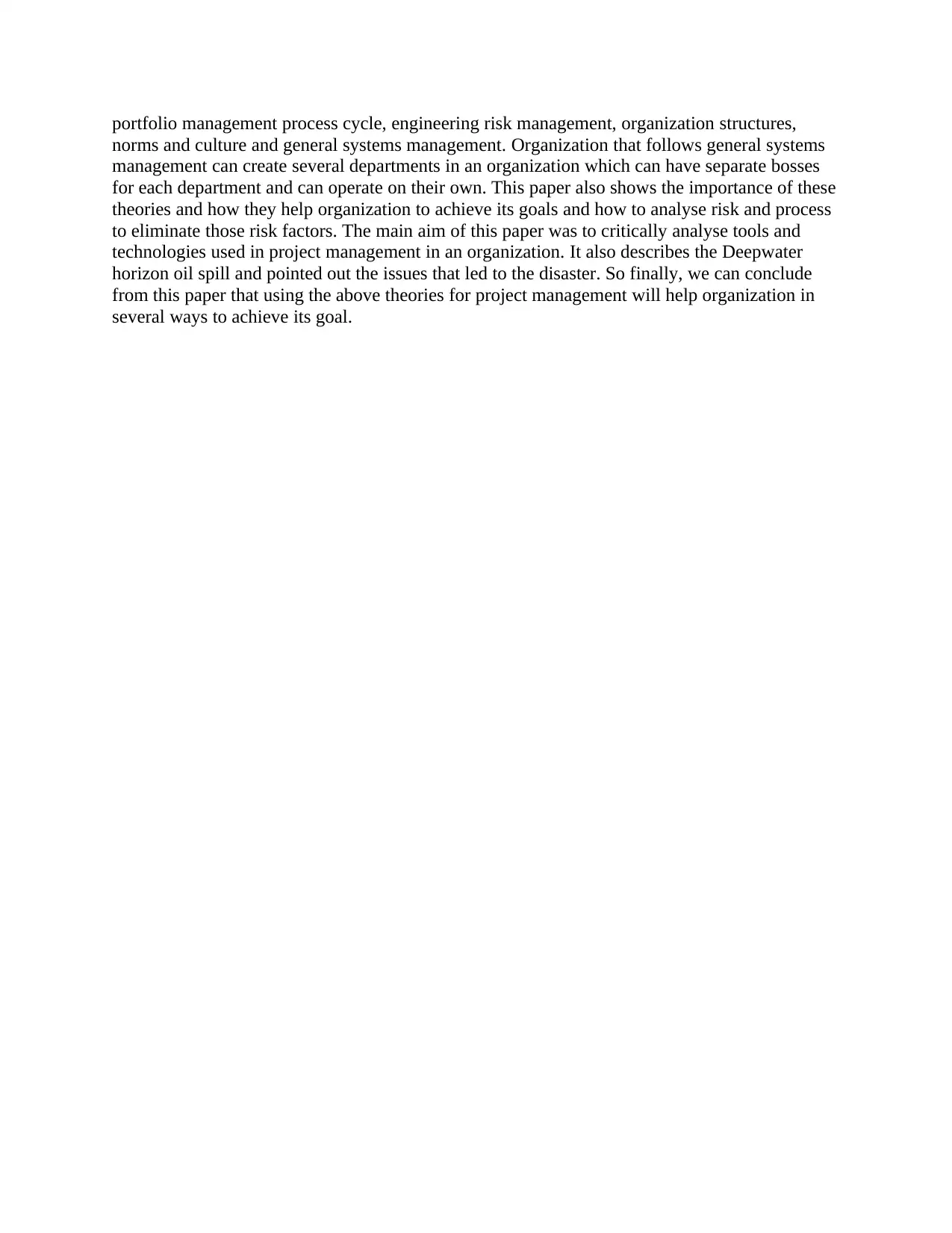
portfolio management process cycle, engineering risk management, organization structures,
norms and culture and general systems management. Organization that follows general systems
management can create several departments in an organization which can have separate bosses
for each department and can operate on their own. This paper also shows the importance of these
theories and how they help organization to achieve its goals and how to analyse risk and process
to eliminate those risk factors. The main aim of this paper was to critically analyse tools and
technologies used in project management in an organization. It also describes the Deepwater
horizon oil spill and pointed out the issues that led to the disaster. So finally, we can conclude
from this paper that using the above theories for project management will help organization in
several ways to achieve its goal.
norms and culture and general systems management. Organization that follows general systems
management can create several departments in an organization which can have separate bosses
for each department and can operate on their own. This paper also shows the importance of these
theories and how they help organization to achieve its goals and how to analyse risk and process
to eliminate those risk factors. The main aim of this paper was to critically analyse tools and
technologies used in project management in an organization. It also describes the Deepwater
horizon oil spill and pointed out the issues that led to the disaster. So finally, we can conclude
from this paper that using the above theories for project management will help organization in
several ways to achieve its goal.
Paraphrase This Document
Need a fresh take? Get an instant paraphrase of this document with our AI Paraphraser
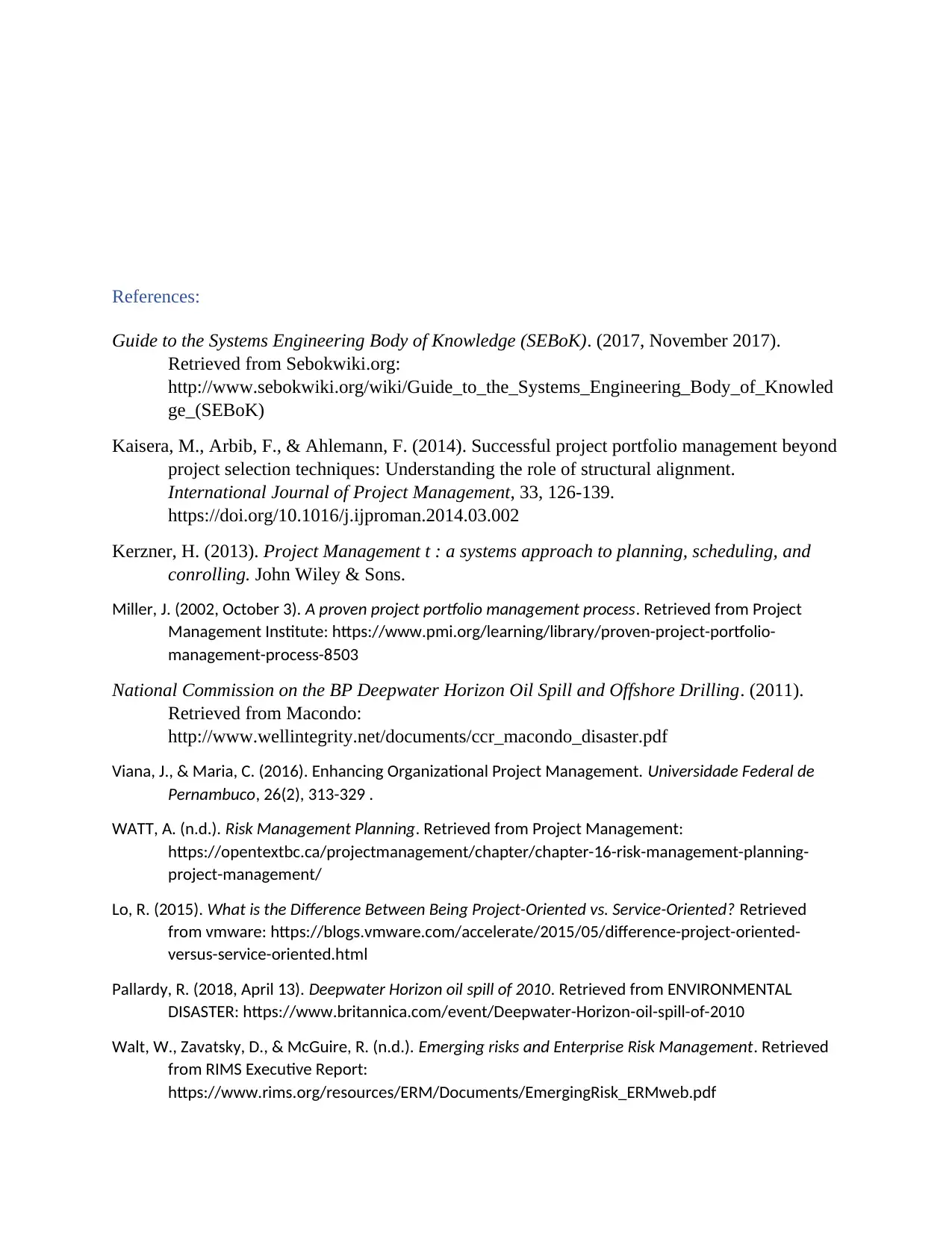
References:
Guide to the Systems Engineering Body of Knowledge (SEBoK). (2017, November 2017).
Retrieved from Sebokwiki.org:
http://www.sebokwiki.org/wiki/Guide_to_the_Systems_Engineering_Body_of_Knowled
ge_(SEBoK)
Kaisera, M., Arbib, F., & Ahlemann, F. (2014). Successful project portfolio management beyond
project selection techniques: Understanding the role of structural alignment.
International Journal of Project Management, 33, 126-139.
https://doi.org/10.1016/j.ijproman.2014.03.002
Kerzner, H. (2013). Project Management t : a systems approach to planning, scheduling, and
conrolling. John Wiley & Sons.
Miller, J. (2002, October 3). A proven project portfolio management process. Retrieved from Project
Management Institute: https://www.pmi.org/learning/library/proven-project-portfolio-
management-process-8503
National Commission on the BP Deepwater Horizon Oil Spill and Offshore Drilling. (2011).
Retrieved from Macondo:
http://www.wellintegrity.net/documents/ccr_macondo_disaster.pdf
Viana, J., & Maria, C. (2016). Enhancing Organizational Project Management. Universidade Federal de
Pernambuco, 26(2), 313-329 .
WATT, A. (n.d.). Risk Management Planning. Retrieved from Project Management:
https://opentextbc.ca/projectmanagement/chapter/chapter-16-risk-management-planning-
project-management/
Lo, R. (2015). What is the Difference Between Being Project-Oriented vs. Service-Oriented? Retrieved
from vmware: https://blogs.vmware.com/accelerate/2015/05/difference-project-oriented-
versus-service-oriented.html
Pallardy, R. (2018, April 13). Deepwater Horizon oil spill of 2010. Retrieved from ENVIRONMENTAL
DISASTER: https://www.britannica.com/event/Deepwater-Horizon-oil-spill-of-2010
Walt, W., Zavatsky, D., & McGuire, R. (n.d.). Emerging risks and Enterprise Risk Management. Retrieved
from RIMS Executive Report:
https://www.rims.org/resources/ERM/Documents/EmergingRisk_ERMweb.pdf
Guide to the Systems Engineering Body of Knowledge (SEBoK). (2017, November 2017).
Retrieved from Sebokwiki.org:
http://www.sebokwiki.org/wiki/Guide_to_the_Systems_Engineering_Body_of_Knowled
ge_(SEBoK)
Kaisera, M., Arbib, F., & Ahlemann, F. (2014). Successful project portfolio management beyond
project selection techniques: Understanding the role of structural alignment.
International Journal of Project Management, 33, 126-139.
https://doi.org/10.1016/j.ijproman.2014.03.002
Kerzner, H. (2013). Project Management t : a systems approach to planning, scheduling, and
conrolling. John Wiley & Sons.
Miller, J. (2002, October 3). A proven project portfolio management process. Retrieved from Project
Management Institute: https://www.pmi.org/learning/library/proven-project-portfolio-
management-process-8503
National Commission on the BP Deepwater Horizon Oil Spill and Offshore Drilling. (2011).
Retrieved from Macondo:
http://www.wellintegrity.net/documents/ccr_macondo_disaster.pdf
Viana, J., & Maria, C. (2016). Enhancing Organizational Project Management. Universidade Federal de
Pernambuco, 26(2), 313-329 .
WATT, A. (n.d.). Risk Management Planning. Retrieved from Project Management:
https://opentextbc.ca/projectmanagement/chapter/chapter-16-risk-management-planning-
project-management/
Lo, R. (2015). What is the Difference Between Being Project-Oriented vs. Service-Oriented? Retrieved
from vmware: https://blogs.vmware.com/accelerate/2015/05/difference-project-oriented-
versus-service-oriented.html
Pallardy, R. (2018, April 13). Deepwater Horizon oil spill of 2010. Retrieved from ENVIRONMENTAL
DISASTER: https://www.britannica.com/event/Deepwater-Horizon-oil-spill-of-2010
Walt, W., Zavatsky, D., & McGuire, R. (n.d.). Emerging risks and Enterprise Risk Management. Retrieved
from RIMS Executive Report:
https://www.rims.org/resources/ERM/Documents/EmergingRisk_ERMweb.pdf

⊘ This is a preview!⊘
Do you want full access?
Subscribe today to unlock all pages.

Trusted by 1+ million students worldwide
1 out of 9
Related Documents
Your All-in-One AI-Powered Toolkit for Academic Success.
+13062052269
info@desklib.com
Available 24*7 on WhatsApp / Email
![[object Object]](/_next/static/media/star-bottom.7253800d.svg)
Unlock your academic potential
Copyright © 2020–2025 A2Z Services. All Rights Reserved. Developed and managed by ZUCOL.





